Capacitors, essential components in electronic circuits, store electrical energy. While many capacitors are non-polarized and can be used in various orientations, a significant category, electrolytic capacitors, are polarized. This means they must be connected to a circuit with the correct polarity to function properly and avoid damage.
By understanding these concepts, you can ensure the longevity and optimal performance of your electronic devices.
Let’s dive in!
What Is Capacitor Polarity
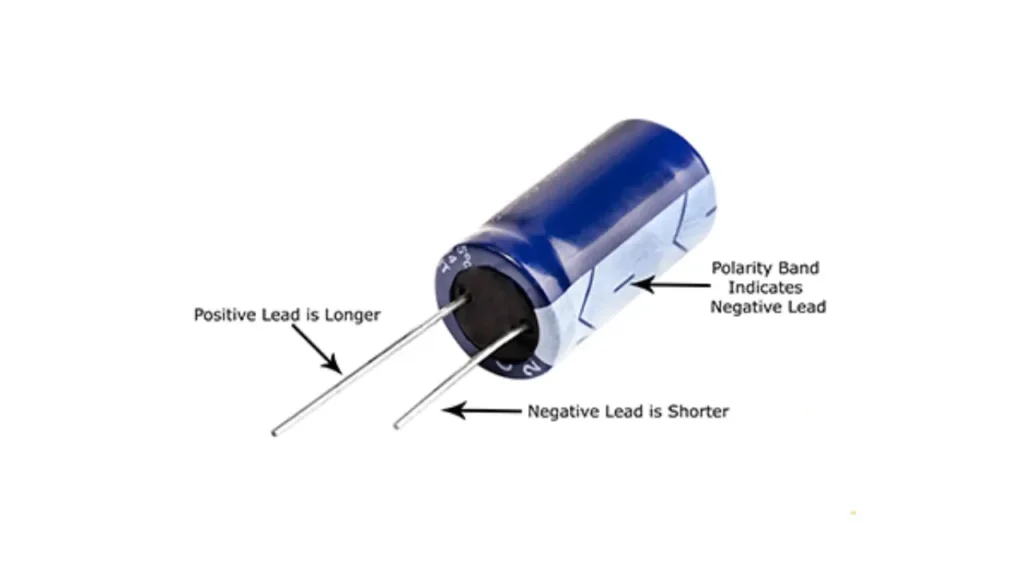
Capacitor polarity refers to the specific orientation of a capacitor’s positive and negative terminals within an electrical circuit. This is determined by the internal structure of the capacitor, which consists of two conductive plates separated by a dielectric material.
Polarized Capacitors
- Electrolytic Capacitors: These capacitors have a defined polarity and must be connected in the correct orientation to function properly. Reversing the polarity can lead to damage or even explosion. The positive terminal is usually marked with a “+” symbol or a longer lead.
- Tantalum Capacitors: Similar to electrolytic capacitors, tantalum capacitors are polarized and have a positive and negative terminal. The positive terminal is usually marked with a “+” symbol or a notch on the casing.
Non-Polarized Capacitors
- Ceramic Capacitors: These capacitors do not have a defined polarity and can be connected in any orientation. They are commonly used in high-frequency applications.
- Film Capacitors: Like ceramic capacitors, film capacitors are non-polarized and can be used in any orientation. They are known for their high stability and low leakage current.
Polymer Capacitor Polarity
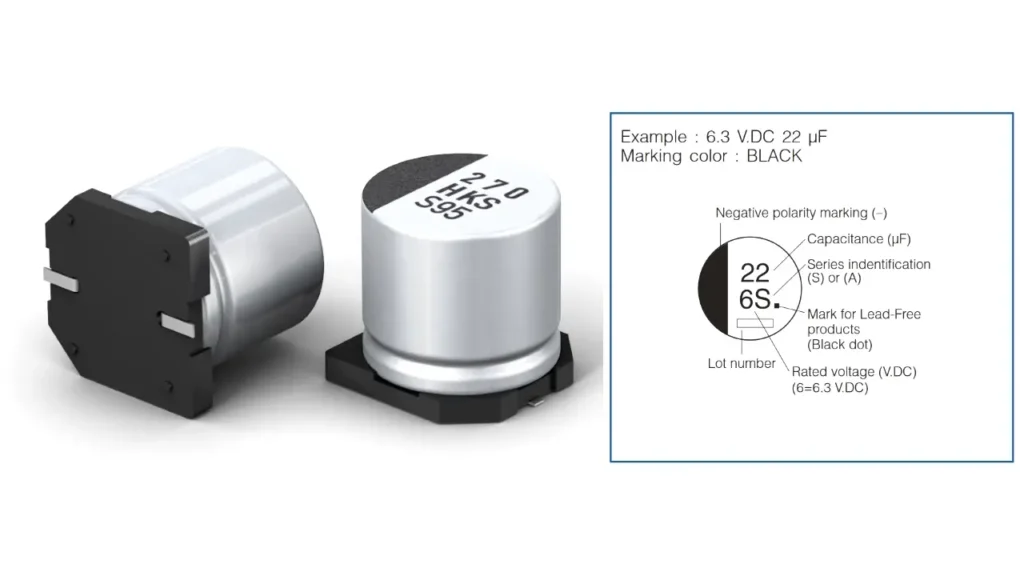
Polymer capacitors, like many other types of capacitors, are polarized components. This means they have a defined positive and negative terminal, and connecting them in reverse polarity can lead to serious damage or even an explosion.
The polarity of a polymer capacitor is typically indicated by markings on the component itself. Common markings include:
- Plus (+) and Minus (-) Signs: The positive terminal is usually marked with a “+” sign, and the negative terminal is marked with a “-” sign.
- Color Coding: Some capacitors use color bands or stripes to indicate polarity.
- Longer/Shorter Leads: The positive terminal often has a longer lead than the negative terminal.
Consequences of Reverse Polarity
- Damage to the Capacitor: When a polymer capacitor is connected in reverse polarity, the internal structure of the capacitor can be damaged. This can lead to a decrease in capacitance, increased leakage current, and ultimately, failure of the component.
- Electrolyte Leakage: In severe cases, reverse polarity can cause the electrolyte within the capacitor to leak, which can damage the surrounding circuitry and pose a safety hazard.
- Explosion: In extreme cases, reverse polarity can cause the capacitor to overheat and explode, potentially damaging other components and posing a significant safety risk.
Preventing Reverse Polarity
- Careful Inspection: Always carefully inspect the capacitor markings to determine the correct polarity before connecting it to the circuit.
- Use of Polarity Protection Devices: In some cases, it may be necessary to use polarity protection devices, such as diodes, to prevent reverse current flow.
- Circuit Design: The circuit design should be carefully reviewed to ensure that the capacitors are connected with the correct polarity.
Are Capacitors Directional
No, capacitors are not directional in the same way that diodes are. However, there are two main types of capacitors:
- Non-polarized capacitors: These can be connected in any direction and are commonly used in AC circuits.
- Polarized capacitors: These have a specific polarity and must be connected with the correct orientation to avoid damage. The most common types of polarized capacitors are electrolytic and tantalum capacitors.
Here’s a table summarizing the key differences:
| Type | Polarity | Usage |
|---|---|---|
| Non-polarized | No specific polarity | AC circuits, general-purpose applications |
| Polarized | Specific polarity | DC circuits, filtering, power supply smoothing |
It’s important to note that while non-polarized capacitors can be connected in any direction, it’s still good practice to follow the manufacturer‘s recommendations for optimal performance.
Capacitor Direct Current
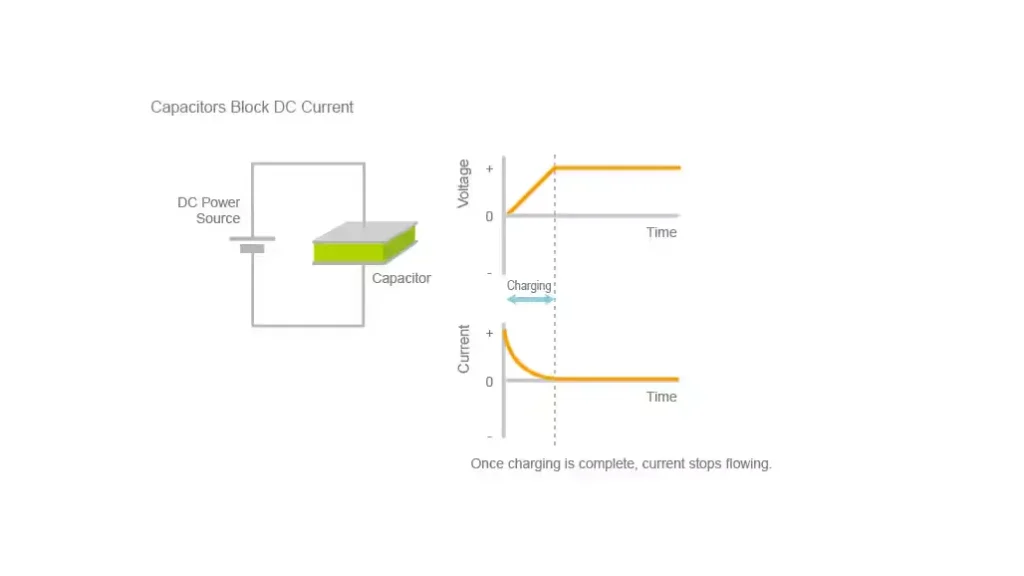
Capacitors and DC
While capacitors are essential components in many electronic circuits, their behavior with direct current (DC) is distinct from their interaction with alternating current (AC).
Key Points:
- Initial Current Flow: When a DC voltage is first applied to an uncharged capacitor, a brief surge of current flows as the capacitor plates charge up. This initial current is necessary to establish an electric field between the plates.
- Steady-State Behavior: Once the capacitor is fully charged, the current flow through it ceases.3This is because the capacitor acts as an open circuit to DC, effectively blocking the flow of steady-state DC current.
- Energy Storage: A charged capacitor stores energy in its electric field. This stored energy can be released later, for example, to power a circuit or smooth out voltage fluctuations.
Visualizing Capacitor Behavior with DC:
Applications of Capacitors in DC Circuits:
Despite their blocking nature to DC, capacitors find various applications in DC circuits:
- Filtering: Capacitors are used to filter out high-frequency noise and ripple from DC power supplies.
- Timing Circuits: Capacitors, in conjunction with resistors, can create timing circuits that control the duration of specific events.
- Coupling: Capacitors can be used to couple AC signals between different stages of a DC circuit while blocking DC.
- Energy Storage: Capacitors can store energy for short periods, such as in camera flashes or backup power systems.
Capacitors have a unique relationship with DC. While they initially allow current flow to charge up, they eventually block the steady-state flow.11 This behavior, combined with their ability to store energy, makes them valuable components in a wide range of electronic circuits.12
Capacitor Polarity Marking
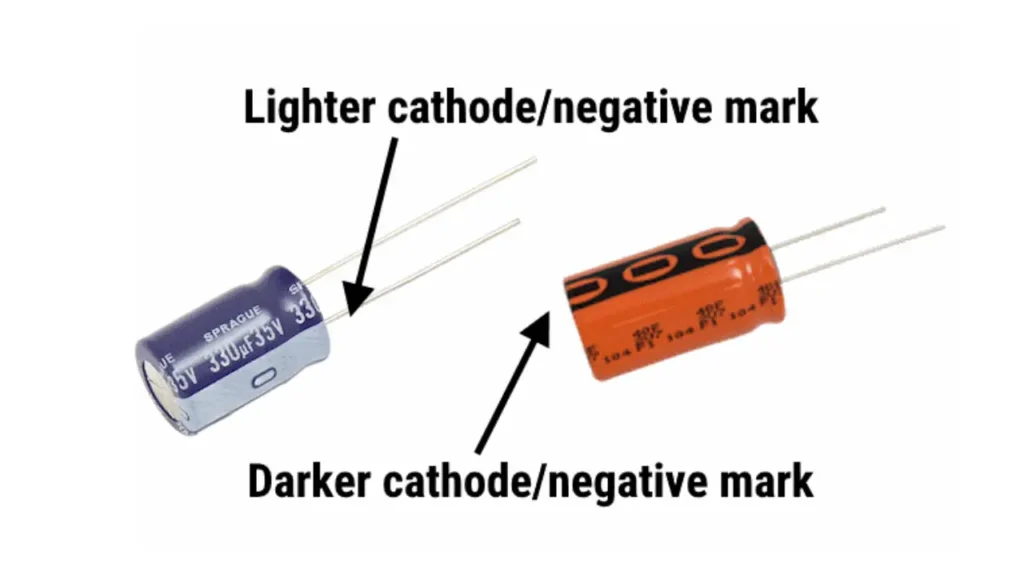
Capacitors, particularly polarized ones like electrolytic and tantalum capacitors, have specific markings to indicate their polarity. Here are some common ways to identify capacitor polarity:
1. Plus (+) and Minus (-) Signs:
The most straightforward method, where a “+” sign indicates the positive terminal and a “-” sign indicates the negative terminal.
2. Colored Bands or Stripes:
Some capacitors use color coding to denote polarity. Typically, a darker band or stripe marks the negative terminal.
3. Lead Length:
In some cases, the positive lead might be longer than the negative lead.
4. Notch or Indentation:
A notch or indentation on the capacitor’s body often indicates the negative terminal.
5. Circuit Board Markings:
The circuit board layout itself might have symbols or markings to indicate the correct orientation for polarized components.
Remember:
- Only polarized capacitors, like electrolytic and tantalum, have polarity.
- Non-polarized capacitors, such as ceramic and film capacitors, can be connected in any orientation.
Always refer to the capacitor’s datasheet or consult an expert if you’re unsure about its polarity. Incorrect polarity can lead to damage or failure of the capacitor and potentially other components in the circuit.
Do Capacitors Have Polarity
Yes, some capacitors have polarity, while others do not.
Polarized Capacitors
- Electrolytic Capacitors: These have a defined positive and negative terminal. Reversing the polarity can cause damage or explosion.
- Tantalum Capacitors: Similar to electrolytic capacitors, they are polarized and require correct orientation.
Non-Polarized Capacitors
- Ceramic Capacitors: These can be connected in any orientation.
- Film Capacitors: Also non-polarized, they offer high stability and low leakage current.
Identifying Polarity
Polarized capacitors typically have markings like:
- “+” and “-” signs
- Color coding
- Physical markings (longer lead or notch)
Always check the datasheet or markings to confirm polarity before using a capacitor.
Identifying Capacitor Polarity
Capacitors typically have markings to indicate their polarity. Common markings include:
- “+” and “-” signs: The most common method is to use a plus (+) and minus (-) sign to indicate the positive and negative terminals, respectively.
- Color coding: Some capacitors use color bands or stripes to indicate polarity.
- Physical markings: The positive terminal may be marked with a longer lead or a notch on the casing.
It is important to always check the capacitor’s datasheet or markings to confirm its polarity before connecting it to a circuit.
Do All Capacitors Have Polarity
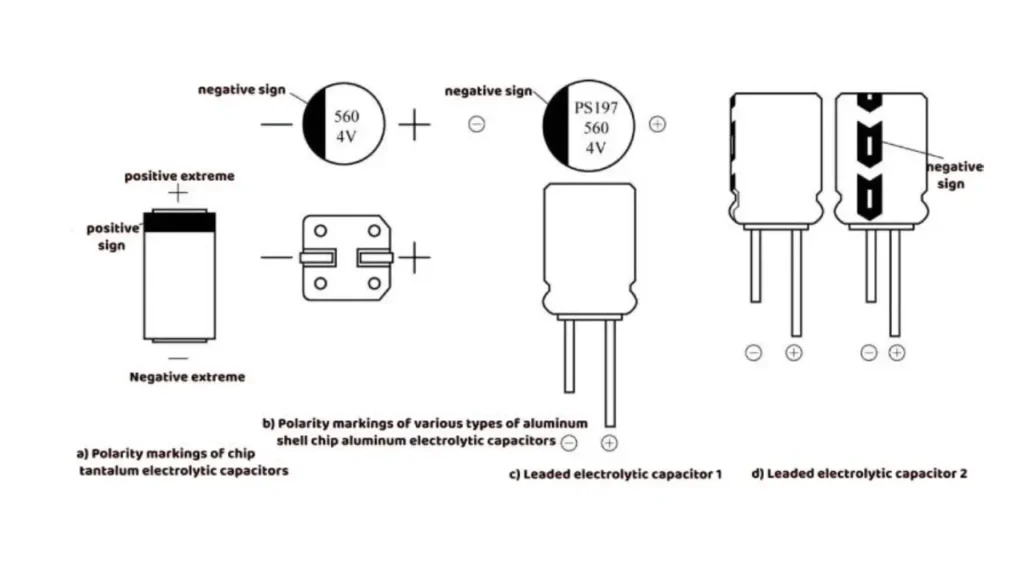
No, not all capacitors have polarity.
Polarized Capacitors:
- Electrolytic capacitors
- Tantalum capacitors
These have a defined positive and negative terminal and must be connected correctly to avoid damage.
Non-Polarized Capacitors:
- Ceramic capacitors
- Film capacitors
These can be connected in any orientation.
It’s important to check the specific type of capacitor you’re using to determine its polarity.
Do Electrolytic Capacitors Have Polarity
Yes, electrolytic capacitors have polarity. They require a specific orientation to function properly. The positive terminal must be connected to a higher voltage than the negative terminal. Reversing the polarity can cause damage or even explosion.
Electrolytic capacitors are commonly marked with a “+” sign or a longer lead to indicate the positive terminal.
Do Film Capacitors Have Polarity
No, film capacitors do not have polarity. They can be connected in any orientation without affecting their performance. This makes them versatile components for various electronic circuits.
Unlike electrolytic capacitors, film capacitors do not have a specific positive or negative terminal.
Do Run Capacitors Have Polarity
No, run capacitors typically do not have polarity. They are designed to operate on AC power and can be connected in any orientation. This is because they are often used in motor circuits where the voltage alternates direction.
However, it’s always a good practice to check the specific capacitor’s datasheet or markings to confirm its polarity or any special requirements.
Do SMD Capacitors Have Polarity
Yes, some SMD capacitors have polarity, while others do not.
The type of SMD capacitor determines whether it has polarity:
Polarized SMD Capacitors
- Electrolytic Capacitors: These have a defined positive and negative terminal. Reversing the polarity can damage the capacitor.
- Tantalum Capacitors: Similar to electrolytic capacitors, they are polarized and require correct orientation.
Identifying Polarity in SMD Capacitors:
- Physical Markings: Look for a “+” symbol or a stripe on the capacitor’s body to indicate the positive terminal.
- PCB Layout: The PCB layout often has markings or a specific orientation for polarized components.
- Datasheet: Consult the capacitor’s datasheet for specific polarity information.
Non-Polarized SMD Capacitors
- Ceramic Capacitors: These can be connected in any orientation.
- Film Capacitors: Also non-polarized, they offer high stability and low leakage current.
It’s crucial to identify the polarity of SMD capacitors before soldering them onto a PCB to avoid potential damage and circuit malfunction.
Do Start Capacitors Have Polarity
No, start capacitors typically do not have polarity.
They are designed to work with alternating current (AC) power, which changes direction periodically. This means that the voltage across the capacitor’s terminals is constantly reversing. As a result, a start capacitor does not require a specific polarity.
You can connect a start capacitor in any orientation without affecting its performance.
Do Tantalum Capacitors Have Polarity
Yes, tantalum capacitors are polarized. This means they must be connected to a circuit with the correct polarity to avoid damage. Incorrect polarity can lead to the capacitor overheating and potentially failing catastrophically.
It’s crucial to pay attention to the polarity markings on the capacitor, which are typically indicated by a “+” sign or a stripe on the casing.
| Capacitor Type | Polarity |
|---|---|
| Electrolytic | Yes |
| Tantalum | Yes |
| Ceramic | No |
| Film | No |
| Run | No |
| Start | No |
Does Capacitor Polarity Matter
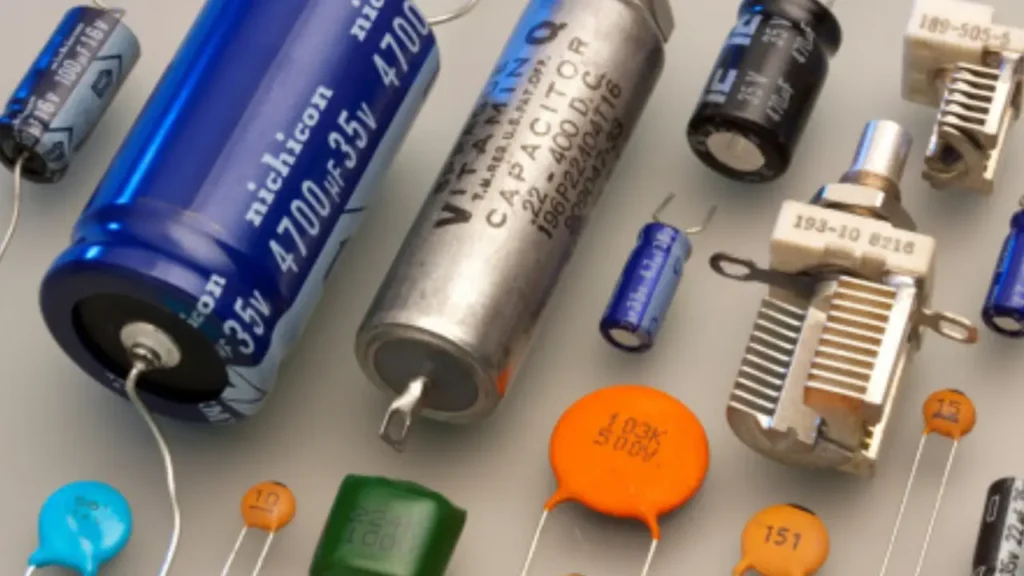
Yes, capacitor polarity matters, especially for polarized capacitors.
Polarized capacitors, such as electrolytic and tantalum capacitors, have a specific positive and negative terminal. Connecting them with incorrect polarity can lead to:
- Damage to the capacitor: Incorrect polarity can cause the capacitor to overheat and potentially explode.
- Circuit malfunction: The capacitor may not function as intended or may cause other components in the circuit to fail.
Non-polarized capacitors, like ceramic and film capacitors, do not have polarity and can be connected in any orientation.
To ensure correct usage, always check the capacitor’s datasheet or markings to determine its polarity.
If you’re unsure, it’s best to consult an electronics expert or refer to the specific circuit diagram.
How Do You Determine the Polarity of a Capacitor
To determine the polarity of a capacitor, you can look for the following markings:
Visual Indicators:
- “+” and “-” signs: These are the most common markings. The “+” sign indicates the positive terminal, and the “-” sign indicates the negative terminal.
- Color bands or stripes: Some capacitors, especially electrolytic and tantalum capacitors, have colored bands or stripes to indicate polarity. The darker band or stripe usually marks the negative terminal.
- Lead length: In some cases, the positive lead might be longer than the negative lead.
- Notch or indentation: Some capacitors have a notch or indentation on the body to indicate the negative terminal.
Circuit Board Markings:
- The circuit board layout often has markings or a specific orientation for polarized components.
Datasheet:
- The capacitor’s datasheet will always provide information about its polarity.
Remember:
- Only polarized capacitors (like electrolytic and tantalum) have polarity.
- Non-polarized capacitors (like ceramic and film) can be connected in any orientation.
If you’re unsure about the polarity of a capacitor, it’s always best to consult the datasheet or seek expert advice. Incorrect polarity can damage the capacitor and potentially other components in the circuit.
How to Identify Capacitor Polarity
Here are common methods to identify capacitor polarity:
Visual Indicators:
- “+” and “-” signs: The most straightforward method, indicating the positive and negative terminals.
- Colored bands or stripes: Often, a darker band marks the negative terminal.
- Lead length: The positive lead is typically longer than the negative one.
- Notch or indentation: This usually marks the negative terminal.
Circuit Board Markings:
- The PCB layout often has symbols or markings indicating the correct orientation for polarized components.
Datasheet:
- The capacitor’s datasheet provides detailed information, including polarity markings.
Remember:
- Only polarized capacitors (like electrolytic and tantalum) have polarity.
- Non-polarized capacitors (like ceramic and film) can be connected in any orientation.
If unsure, always consult the datasheet or seek expert advice to avoid damaging the capacitor or the circuit.
Is a Capacitor Polarity Sensitive
Yes, some capacitors are polarity sensitive.
Specifically, electrolytic and tantalum capacitors are polarized. This means they must be connected to a circuit with the correct polarity to avoid damage. Incorrect polarity can lead to the capacitor overheating and potentially exploding.
Non-polarized capacitors, such as ceramic and film capacitors, can be connected in any orientation.
To ensure correct usage, always check the capacitor’s datasheet or markings to determine its polarity.
Conclusion
In conclusion, understanding the polarity of capacitors is crucial for their correct implementation in electronic circuits. While electrolytic capacitors possess a defined polarity, ceramic and film capacitors are typically non-polarized. Misusing polarized capacitors can lead to damage or reduced performance.
Need high-quality capacitors for your next project? Look no further! Weishielectronics offers a wide range of capacitors, including polarized and non-polarized types, to meet your specific requirements. Our products are sourced from reputable manufacturers and undergo rigorous quality control to ensure reliability and performance.
Visit our website or contact our sales team today to learn more about our capacitor offerings and to place your order.